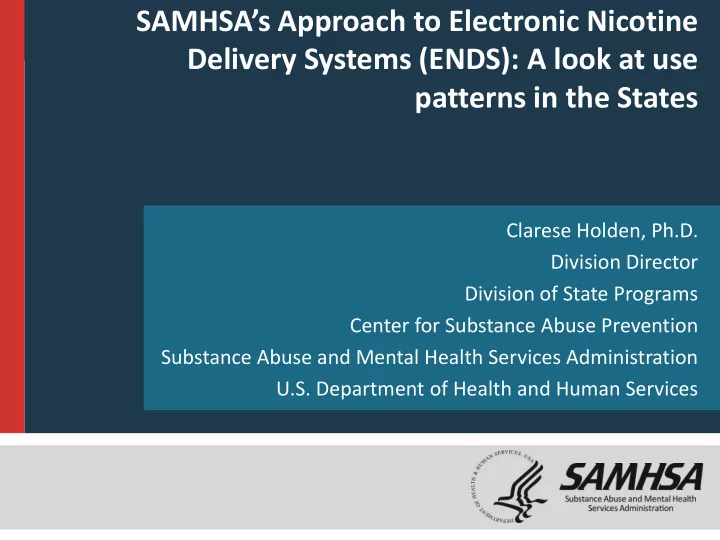

SAMHSA’s Approach to Electronic Nicotine Delivery Systems (ENDS): A look at use patterns in the States Clarese Holden, Ph.D. Division Director Division of State Programs Center for Substance Abuse Prevention Substance Abuse and Mental Health Services Administration U.S. Department of Health and Human Services
Description of the Prevalence of ENDS Use • According to the 2017 Youth Risk Behavior Surveillance System (YRBSS): – 2.2% of students had ever used an electronic vapor product – 13.2% of students nationwide had used an electronic vapor product on at least 1 day during the 30 days before the survey – 3.3% of students had used an electronic vapor product on 20 or more days during the 30 days before the survey – 2.4% of students had used electronic vapor products on all 30 days during the 30 days before the survey 2 Data available at: https://www.cdc.gov/features/yrbs/index.html
High School Student Demographics at Risk • For ever used, currently use, or frequently use an electronic vapor product: – Male, White, Gay, lesbian, bisexual are all highest risk • For daily use of an electronic vapor product: – Male, Hispanic, Heterosexual are all highest risk Data available at: https://www.cdc.gov/features/yrbs/index.html 3
Prevalence of Marijuana Use Amongst Youth According to the 2016 National Survey on Drug Use (NSDUH) and Health Data: 2016 Amongst 12-17 year olds • Lifetime Use of Marijuana in 2015 was 15.7%, and 14.6% in 2016 • Past Year usage in 2015 was 12.6% and 12.0% in 2016 • Past month usage in 2015 was 7.0% and 6.5% in 2016 • 2016 National Survey on Drug Use (NSDUH) and Health Data 2016 National Survey on Drug Use (NSDUH) and Health Data Data available at: https://www.samhsa.gov/data/data-we-collect/nsduh-national- survey-drug-use-and-health 4
NSDUH Data (continued) Amongst 12-17 year olds in 2016: • Lifetime Use of Marijuana was 14.8% among males and 14.7% among females • Past Year usage was 11.7% among males and 12.3% in females • Past month usage was 6.8% among males and 6.1% in females • Use was highest in the Northeast, large metro or urbanized areas, and 100-199% poverty level 5
NSDUH Perception of Harm Data Amongst 12-17 year olds: • Smoking Marijuana once a month: 27.1% • Smoking Marijuana one or twice a week: 40.0% Average number of days used in past year: • In 2015 82.3, in 2016 76.4 Average number of days used in past month: • In 2015 24.0, in 2016 22.8 6
SAMHSA’s Response • Adhering to guidance from FDA’s regulatory plan – continuum of risk with combustible cigarettes as the most harmful – Utilizing messaging and retailer education on ENDS 7
Youth Access Prevention • Efforts to control youth access are successful when they involve – the community – tobacco retailers – enforcement agencies – community groups – multifaceted interventions 8
A Comprehensive Synar Program • A comprehensive Synar program includes the following: – Needs Assessment and Strategic Planning – Policy and Regulatory Approaches – Enforcement of Merchant Compliance – Interagency Collaboration and Networking – Community Education and Support, Including Media Advocacy – Merchant Education – Youth Involvement – Integration of Synar Into Overall Prevention Efforts – Integration of Synar Into Statewide Tobacco Control Efforts 9
National Weighted Retailer Violation Rate, FFY 1997 – FFY 2013 45 40.1 40 35 30 Retailer Violation Rate (%) 25.4 25 20.5 20 20 17.5 16.3 14.1 15 12.8 11.6 10.8 10.5 10.9 9.9 9.6 9.3 9.1 10 8.5 5 0 1997 1998 1999 2000 2001 2002 2003 2004 2005 2006 2007 2008 2009 2010 2011 2012 2013 Federal Fiscal Year 10
The Synar Program is Effective • Since the program was created the RVR has gone down from 40.1% in 1997 to 9.6% in 2013. • Youth tobacco use prevalence rates have dropped, but have leveled off. • Synar is a critical component of the success of youth tobacco prevention efforts. 11
Practices for Reducing Youth Access Reported by Successful States • Regular and statewide enforcement of merchant compliance with youth tobacco access laws • Policy and regulatory approaches: – Enacting and enforcing tobacco license laws – Required merchant education – Attorney General Assurances of Voluntary Compliance 12
Practices for Reducing Access Reported by Successful States • Merchant education – Non-enforcement compliance checks conducted by community members – Warning noncompliant merchants about youth access laws – Providing positive reinforcement to compliant merchants • Community education and support through: – Public education media campaigns – Support for community-led prevention activities 13
Thank You For questions regarding the Synar program, go to https://www.samhsa.gov/synar or contact your CSAP Block Grant/Synar Project Officer. 14
Recommend
More recommend